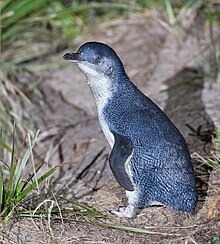The genus Eudyptula ("good little diver") contains two species of penguin, found in southern Australia, Tasmania, and New Zealand (including the Chatham Islands). They are commonly known as the little penguin, little blue penguin, or, in Australia, fairy penguin. In the language of the Māori people of New Zealand, little penguins are known as kororā.[3]
| Eudyptula Temporal range: [1]
| |
|---|---|

| |
| Australian little penguin near burrow at night, Bruny Island, Tasmania, Australia | |
| Scientific classification | |
| Domain: | Eukaryota |
| Kingdom: | Animalia |
| Phylum: | Chordata |
| Class: | Aves |
| Order: | Sphenisciformes |
| Family: | Spheniscidae |
| Genus: | Eudyptula Bonaparte, 1856 |
| Type species | |
| Aptenodytes minor[2] | |
| Species | |
For many years, a white-flippered form of the little penguin found only in North Canterbury, New Zealand was considered either a separate species, Eudyptula albosignata, or just a subspecies, Eudyptula minor albosignata. Analysis of mtDNA revealed that Eudyptula falls instead into two groups: a western one, found along the southern coast of Australia and the Otago region of New Zealand, and another found in the rest of New Zealand.[4] These two groups are now considered full species: Eudyptula novaehollandiae in Australia and Otago, and Eudyptula minor elsewhere.[5] E. novaehollandiae probably arrived in New Zealand from Australia less than 500 years ago, following the local extinction of E. minor in Otago.[6]
Classification edit
Order Sphenisciformes
- Family Spheniscidae
- Genus Eudyptula
- Eudyptula minor – little penguin
- Eudyptula novaehollandiae – Australian little penguin
- †Eudyptula wilsonae[1]
- Genus Eudyptula
Extant Species edit
| Image | Scientific name | Common Name | Distribution |
|---|---|---|---|
| Eudyptula minor | little penguin | New Zealand, Chatham Islands | |
| Eudyptula novaehollandiae | Australian little penguin | Southern Australia, Otago |
Fossil species edit
| Image | Scientific name | Distribution |
|---|---|---|
| Eudyptula wilsonae[1] | Tangahoe Formation, Taranaki, New Zealand |
References edit
- ^ a b c Thomas, Daniel B; Tennyson, Alan JD; Marx, Felix G; Ksepka, Daniel T (2023). "Pliocene fossils support a New Zealand origin for the smallest extant penguins". Journal of Paleontology. 97 (3): 711–721. Bibcode:2023JPal...97..711T. doi:10.1017/jpa.2023.30.
- ^ (Commentationes Societatis Regiae Scientiarum Gottingensis 3 (1780): 135, 147.
- ^ Flemming, S.A. (2013). "Little penguin". NZ Birds Online. Retrieved 24 July 2018.
- ^ Banks, Jonathan C.; Mitchell, Anthony D.; Waas, Joseph R.; Paterson, Adrian M. (2002). "An unexpected pattern of molecular divergence within the blue penguin (Eudyptula minor) complex" (PDF). Notornis. 49 (1): 29–38.
- ^ Grosser, Stefanie; Burridge, Christopher P.; Peucker, Amanda J.; Waters, Jonathan M. (2015-12-14). "Coalescent Modelling Suggests Recent Secondary-Contact of Cryptic Penguin Species". PLOS ONE. 10 (12): –0144966. Bibcode:2015PLoSO..1044966G. doi:10.1371/journal.pone.0144966. ISSN 1932-6203. PMC 4682933. PMID 26675310.
- ^ Grosser, Stefanie; Rawlence, Nicolas J.; Anderson, Christian N. K.; Smith, Ian W. G.; Scofield, R. Paul; Waters, Jonathan M. (2016-02-10). "Invader or resident? Ancient-DNA reveals rapid species turnover in New Zealand little penguins". Proceedings of the Royal Society B: Biological Sciences. 283 (1824): 20152879. doi:10.1098/rspb.2015.2879. ISSN 1471-2954. PMC 4760177. PMID 26842575.